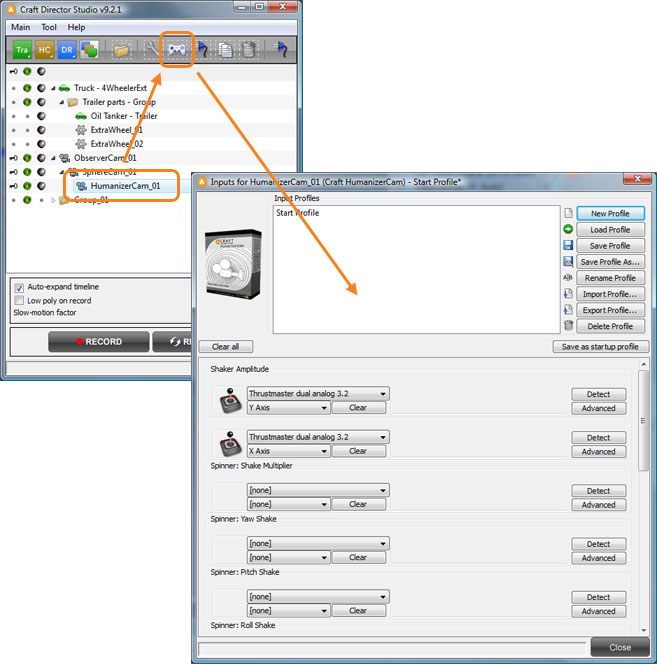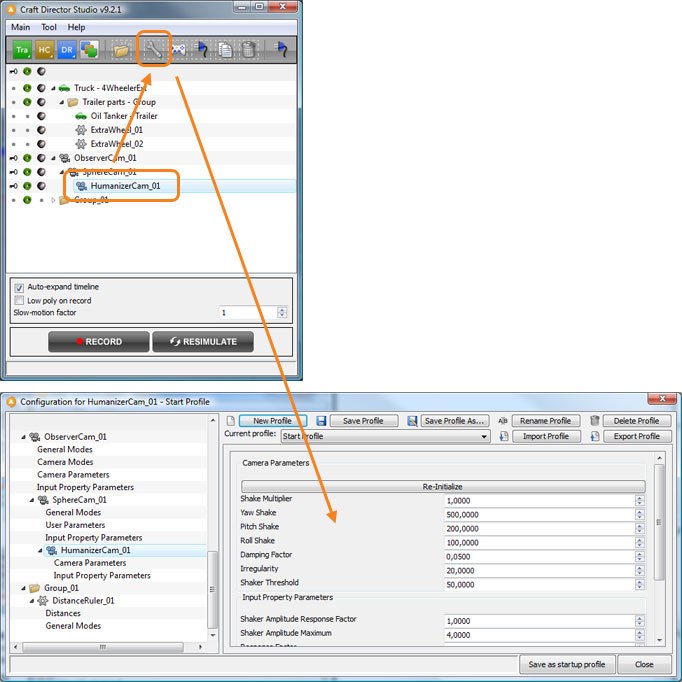
Craft ZeroGCam is modeled as a body in zero gravity. A selection of brakes has been added to Craft ZeroGCam because controlling weightless objects is too difficult otherwise. Once the tool is mastered it will yield spectacular shots that are completely unprecedented. Even though any supported input device can be used, the most natural device for this camera is a 3d-mouse (i e from 3DConnexion).
Craft ZeroGCam can also be bound to another Craft Director Studio camera or vehicle to give an extra layer of movement.
Using Craft ZeroGCam
 Optimizing the scene Optimizing the scene
It’s wise to optimize the scene before starting to recording the animation. The scene is optimized by decreasing the amount of polygons shown during the recording. This is achieved by hiding objects not crucial to the part of the scene to be animated. Another tip is to use Craft Bounding Poly, which temporary lowers the amount of polygons for selected objects and allows for a smoother recording. |
- Create a Craft ZeroGCam.

- Configure the Input settings for Craft ZeroGCam (using an analog input device is recommended).
To configure the Input settings for Craft ZeroGCam select Craft ZeroGCam in the tool tree list and click the Input settings button. This will open the input settings window for Craft ZeroGCam.

- Position the camera at the position you want it to start from.
- The Humanoid mesh shows you in what scale the Craft ZeroGCam is in. To change the scale go to the Configure window and change the value of relative scale under Camera Parameters.
- Press Record and use the inputs you configured earlier to control the camera.
- If the recording is not satisfactory drag the timeline back to any position and continue to re-record from there. This way the entire recording does not have to be redone.
- By using the Countdown feature, you can give yourself time to move your hand to the input device and get ready before the recording starts. You can find the settings for Countdown in the Craft Director Studio Preferences. Craft Director Studio Preferences can be opened from the main menu.
- To make it easier to maneuver tricky parts in the animations, use the Slow-motion factor in Craft Director Studio’s main window.
Input settings

Forw/Backw Force
Increases/Decreases the speed the camera is moving forward/backward.![]()
Right/Left Force
Increases/Decreases the speed the camera is moving right/left.
Up/Down Force
Increases/Decreases the speed the camera is moving up/down.
Yaw Force (Right/Left)
Increases/Decreases the speed the camera is rotating (yaw).
Pitch Force (Up/Down)
Increases/Decreases the speed the camera is rotating (pitch).
Roll Force (Right/Left)
Increases/Decreases the speed the camera is rotating (roll).
Airplane Brake
Brakes all translation and rotation movement the camera has, except in the forward (or backward) direction.
Brake All
Brakes all translation and rotation movement.
Translational Brake
Brakes all translation movement.
Rotational Brake
Brakes all rotation movement.
Spinner…
Spinners enables the change of parameter values with an input controller in real-time.
Configure

Hide Modes
Hide Helpers
Hides the Helpers.
Hide Helpers During Recording
Hides the Helpers during recording.
Hide Camera
Hides the Camera.
Camera Parameters
Relative Scale
This value can be used to adjust all of the camera’s movement settings to the scene’s scale. A higher value will increase the movement of the camera which can be needed in a scene using a big scale as working units(meter, yard, kilometer, etc.).
The Humanoid dummy gives a good scale representation of the current Relative Scale. It is possible to scale the ZeroGCam directly in the scene to change the Relative Scale.
Field Of View
The field of view.
Target Distance
Distance to the target.
Input Property Parameters
Forw/Backw Force Response Factor
How fast the camera accelerates and decelerates (forward/backward).
Forw/Backw Force Maximum
Maximum forward/backward speed of the camera.
Right/Left Force Response Factor
How fast the camera accelerates and decelerates (right/left).
Right/Left Force Maximum
Maximum right/left speed of the camera.
Up/Down Force Response Factor
How fast the camera accelerates and decelerates (up/down).
Up/Down Force Maximum
Maximum up/down speed of the camera.
Yaw Force (Right/Left) Response Factor
How fast the camera’s rotational movement accelerates and decelerates (yaw right/left).
Yaw Force (Right/Left) Maximum
Maximum (yaw) rotation speed of the camera.
Pitch Force (Up/Down) Response Factor
How fast the camera’s rotational movement accelerates and decelerates (pitch up/down).
Pitch Force (Up/Down) Maximum
Maximum (pitch) rotation speed of the camera.
Roll Force (Right/Left) Response Factor
How fast the camera’s rotational movement accelerates and decelerates (roll right/left).
Roll Force (Right/Left) Maximum
Maximum (roll) rotation speed of the camera.
Airplane Brake Response Factor
A value for how fast this function will react to the input. A value of 1 yields instant reaction and a lower value will add a fade in for the reaction.
Airplane Brake Maximum
How much force that will be used to brake the camera.
Brake All Response Factor
A value for how fast this function will react to the input. A value of 1 yields instant reaction and a lower value will add a fade in for the reaction.
Brake All Maximum
How much force that will be used to brake the camera.
Translational Brake Response Factor
A value for how fast this function will react to the input. A value of 1 yields instant reaction and a lower value will add a fade in for the reaction.
Translational Brake Maximum
How much force that will be used to brake the camera.
Rotational Brake Response Factor
A value for how fast this function will react to the input. A value of 1 yields instant reaction and a lower value will add a fade in for the reaction.
Rotational Brake Maximum
How much force that will be used to brake the camera.